Tags

The Wheel of Dhamma
I came to Theravada Buddhism very slowly. Over the last 25 years or so I have investigated Wicca, the occult Western Tradition (The Golden Dawn etc.), I have investigated Aleister Crowley‘s Thelema, I have investigated Christianity quite heavily in many of its guises (both Protestant and Catholic), and I had a brief, yet wholly unproductive flirtation with Islam. I must admit the Koran, in English, is painfully unreadable but maybe that is just me.
Reiki
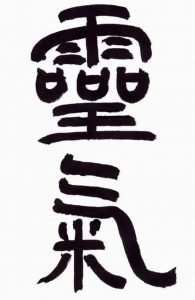
Reiki
For some reason I never considered Buddhism as an avenue to look into until I came across the Japanese complementary therapy known as Reiki. Back in 2010 I was made redundant whilst diagnosed with severe depression and stress anxiety. Being made redundant did those conditions no favours and the medication I am on did not seem to be working too well so I started looking at the alternative market for something to try. My investigations lead me to Reiki. It is a Japanese form of hands on energy therapy that can be used to aid in the healing of almost anything. What surprised me was the founder, Mikao Usui, had Buddhist training and had used Buddhist techniques in developing his methods of assisting in the healing of various ills, including mental problems.
Rather than pay out for 6 to 8 sessions with a Reiki healer, I decided it would actually be cheaper to get trained myself, so here I am, a fully qualified Reiki Master (my lineage is available upon reasonable request). I must admit, Reiki works! It really does help.
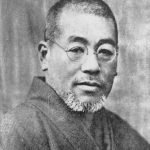
Mikao Usui
Like I said, I believe Mikao Usui used certain Buddhist training in the development of his therapy, so this piqued my interest and I started to look into what Buddhism was all about, aside from all the Vippassana meditation schools and Mindfulness training schools that have sprung up in the West. I wanted to know the nitty-gritty of Buddhism; the hard-core stuff. If I investigate anything; I want to know it from its beginnings, that is just the way I am built.
The Dalai Lama
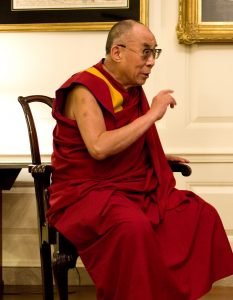
The Dalai Lama
Because of the influence that the Dalai Lama has had in the West over the last 40-50 years or so, I naturally had a ready supply of Tibetan Buddhist books to read, but something about it all, basically the Mahayana tradition, tugged at my suspicion and I wasn’t wholly convinced that it was the branch of Buddhism I needed to follow.
There were too many rituals, Gods, Devas, and the like that seemed to take up a lot of your time and not working on your own mind. There are ‘secret’ practices and ’empowerments’ you have to go through if you are to progress on their respective paths. In Tibet, there are four main schools of thought and they all have their own take on the Buddha’s teachings and what is required to advance toward Nibbana. Maybe I am wrong but that is the impression I got. I have read several of the Dalai Lama‘s books and they are brilliant. He is clear and lucid in his explanations and I would heartily recommend them to anyone interested in the Buddhist faith, but for me, something was still missing. Something was not quite right. And that ‘something’ was the Pali Cannon, the Suttas themselves. So much of Tibetan Buddhism relies on the commentaries written by the likes of Nagarjuna and Milarepa that they seem to have lost sight of the actual words the Buddha spoke. Maybe I am wrong again in this aspect, but that is the impression I got.
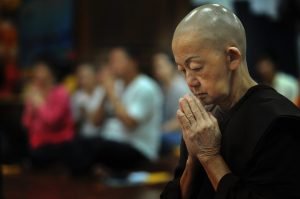
Theravada Buddhism
Theravada Buddhism
And so I came to Theravada Buddhism. The most ancient Buddhist practice currently active, and the closest it is believed to how the ancients used to practice when the Buddha walked this earth. They pay close attention to the Sutta Pitaka. They pay close attention to the Vinaya Pitaka as well, the Buddhist Monastic code. Study and meditation play a significant part in daily practice for the monks and nuns of a Theravada Monastery. It is this devotion to the word of the Buddha that speaks to me. He was, after all, the Awakened One.
So I am now happy. I know more peace than I have ever done in the past. I have bought as much of the Sutta Pitaka as I can do at the moment and have taken advantage of the generosity of both Amaravati Monastery in the U.K. and Metta Forest Monastery in the U.S.A. with their free offerings of books and audio recordings on the Dhamma.

The Tipitaka
Sources of Dhamma
Much literature can be gained from those sources because they are given freely as a gift of Dana. Dana is giving of something without any expectation for something in return. Charity at it’s grass roots, and as the Lord Buddha has said ‘The gift of Dhamma excels all other gifts’.
Both institutions accept monetary donations through their websites, so if you feel you have benefited from the Dhamma they have sent you, then I heartily recommend that you donate at least something, even if it is just $1 or £1, they will be most grateful and you will earn ‘merit’ in doing so.
God’s, Deva’s and Demons
Theravada Buddhism is not for everybody, just like any other faith or practice. I do not believe Buddhism to be a ‘religion’ per se, because there is no overall ‘deity’ that you have to follow and obey. Certainly their are ‘gods’, ‘devas’ and ‘demons’ that exist, much the same as the ‘gods’, ‘angels’ and ‘demons’ in the Christian faith (the Jewish/Christian/Islamic God admits that there are other gods when Jehovah commands “Though shalt have no other God but Me”, which, logically, implies there are other Gods), but the Buddhist gods do not command worship, and, to be honest, they are not worthy of worship. Gods and Devas are just as prone to the frailties of emotional reaction as we are. They have not yet escaped Samsara so they are still on the path that you and I find ourselves on. You only have to look at the Christian god to realise how self serving, jealous and violent he can be; all of those being human traits, and even sins according to Jehovah. Double standards anyone?

Monkey
The Noble Eightfold Path is the only exit from the round of rebirth and death (Samsara). The Buddha rediscovered it 2400-2500 years ago, and the scribes of those times have left a priceless treasure in the form of the Pali Cannon for us to learn from, and practice. If you were to be presented with the entire Pali Cannon, translated into English, you would be overwhelmed. There is an enormous amount of material available, yet you do not need to know, nor read it all, to start practicing. There is an English saying that goes something like this; “Slowly Slowly Catchy Monkey”. Quite why you want to catch a monkey I do not know, but slowly is the method to approach the Dhamma; and so it would seem, if you want to catch a monkey, it is the same approach that is needed.
Conclusion
So that is pretty much how I ended up as a practicing Theravada Buddhist. There are still aspects of Aleister Crowley’s Thelema that I believe in. They tend to be the philosophical and psychological aspects and not the Ritual Magick aspects of his teachings, but in those teachings there is little to be scared of if you have your head screwed on correctly.
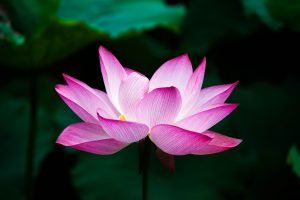
Lotus Flower
I have a small shrine to the Buddha in my living room that I tidy up daily after our cats have run amuck all over it. I practice the Mindfulness of Breathing as often as I can throughout the day, and I read the Suttas as often as my brain allows me to. As a beginner, I believe I am doing well.
Baby Steps
This is all you need to do to start your practice. Start small… start slow. ‘Nibbana or Bust!’ is not the order of the day because you WILL fail. Nibbana is the goal, but you have spent millennia in the sea of Samsara, so to expect an instant exit is unrealistic at it’s best. If you have a monastery close by then take full advantage of it. Attend their Dhamma talks, attend their meditation sessions, attend their retreats. Become involved in the Buddhist community, make friends and find colleagues to practice with. This is part of becoming a member of the Sangha, one of the three Jewels of Buddhism.
From then on, your path will open up to you as your needs become more clear. Take advice from your new-found friends and your teachers. The path is long, but, as you will find, it is not a lonely path.
May all Sentient Beings live free from fear!
